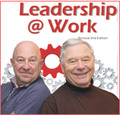Decision making is an essential business and leadership skill, and whether you’re a CEO hammering out strategy with your vice presidents or a soccer coach whose team is choosing new uniforms, it’s your influence ‘behind the scenes’ that ultimately determines how successful the final decision will be. Or so says Harvard Business School's Michael A. Roberto in his book "Why Great Leaders Don't Take Yes for an Answer".
In today’s performance-obsessed business climate managers are evaluated on their ability to produce the desired results. As a result, when managers need to make an important decision they tend to forget that the success of any decision relies as much on quality implementation as it does on picking the right strategy. And according to Roberto, a leader’s ‘people skills’ are the key to successful implementation:
"A leader’s ability to navigate his or her way through the personality clashes, politics, and social pressures of the decision process often determines whether managers will select the appropriate alternative and implementation will proceed smoothly."
Roberto points out that while a vigorous exchange of views leads to better quality decisions, successful implementation depends on reaching a committed consensus. The million dollar question is how do you move your team from debate to consensus?
Roberto contends that the best way to do that is to "actively shape and influence the conditions under which people will interact and deliberate." In other words, carefully choosing your actors and setting the stage before launching the actual search for solutions is a great leadership strategy and a key difference between leadership vs management.
Start by defining the problem to be solved and the objectives that must be met. Carefully select your decision-making team—generally, people who care about or will be affected by the outcome; who have useful expertise; and/or whose authority, influence or cooperation will be needed for success.
Most importantly, create in advance an objective process for evaluating alternatives and choosing the best solution. Usually this will be some sort of system for rating how well each proposed solution meets the required objectives and constraints. This one simple precaution will help you sidestep the potential pitfalls of personality conflict, emotional investment and internal politicking.
Other points to remember while deliberating:
1. There IS such a thing as too much information. Don’t let your team fall into the trap of ‘analysis paralysis’.
2. Trust yourself and your team. In most cases, any decision is better than no decision. There is no such thing as a perfect decision, so don't drive yourself crazy striving for perfection.
Leadership skills builder:
1. What is my current method for making business decisions?
2. Do I actively guide the decision-making process instead of focusing solely on finding the ‘best’ solution?
3. Do I solicit input from 'experts' and 'stakeholders' or do I tend to fly solo?
4. If I tend to fly solo, have I forgotten that ‘two heads are better than one?’
5. Do I think carefully about who to include in my decision-making teams?
6. Do I create a safe environment for my team to propose and debate a diversity of options?
7. Do I use reasonable, fair and objective criteria for selecting a solution?
8. If not, how might I fine-tune the process to reduce the influence of personality clashes, internal politics, and social or emotional pressures?
Build skills and advance your career with self-guided management leadership training. Bart Mindszenthy and Harvey Silver have more than 80 years of combined expertise in management and leadership consulting across all sectors while concurrently providing focused training programs across North America. Their bestselling book "Leadership@Work:Be a Better Team Leader Anytime, Anywhere, with Anyone" offers practical, hands-on guidance on becoming a more effective leader today.

Post new comment
Please Register or Login to post new comment.